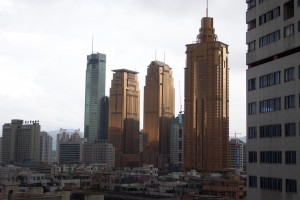
Signs of growth – stronger growth – abound. Car sales are up by double-digits in 2012, and 2013 looks even better, perhaps 20 million units? (The US may hit 15 million, sales in the EU are in freefall.) China is the most important market for both GM and VW. Chinese exports are up, suggesting that perhaps the downturn in Europe will be mutedin its global impact by growth in the US and the rest of Asia (I don’t follow Latin America…). And so on.
But is this all good news? What problems does strong growth bring? How should China respond? I don’t want to fill in the details: that’s your challenge in blogging this term. For the time being, we’re focused on microeconomic issues. From your end, potential topics are
- (i) the harbingers of growth, and their reliability (remember that macro statistics are noisy in the short run) and
- (ii) the side effects of growth, micro and macro.
Of course, there are many factors that can be harbingers of growth, but here are three possible factors to be considered:
1) Which consumers are buying cars? Probably not the rural migrant workers who are coming to cities in huge numbers for menial labor even though their wages have increased dramatically over the past few years (Wall Street Journal Blog), but maybe it is the middle class worker who uses a car daily for work (cabbies and truck drivers) or the upper class who can afford to have cars for private transportation or conspicuous consumption.
2) What kinds of cars are being bought? Although we hope China would curb its growing pollution problems, ironically, the fastest growing segment of car sales is SUVs (Zacks Equity Research). With the high price of gasoline in China and SUVs’ low mpg rates, are people buying these cars to use for work or for conspicuous consumption? Can this kind of consumption be considered a stable source of growth?
3) Could consumers be buying more cars due to lower car prices? Prices have dropped not only in the second-hand luxury brand car market (China Times but also possibly for cars overall because of the low price of overproduced steel (China Daily).
In terms of side effects, the one big thing that jumps out is the strain on the environment that producing this many cars and having them on the road will bring. Similarly, traffic in Beijing and other densely populated Chinese cities is already extremely high, and with more cars on the road, this negative externality will also increase.
Sources:
Wall Street Journal Blog discussing the importance of of migrant laborers in China and the global economy and their income, living arrangements, and limitations under the hukuo system: http://blogs.wsj.com/chinarealtime/2013/01/04/what-worker-shortage-the-real-story-of-chinas-migrants/
Zacks Equity Research detailing the growth of China’s auto market over the past year and projected growth for this year: http://www.zacks.com/stock/news/90352/china-auto-sales-lag-guidance
China Times revealing data about the 2nd hand luxury car market: http://www.chinacartimes.com/2012/09/27/buy-premium-car-china-time/
and China Daily mentioning the overproduction of steel and its domestic and global impacts on the steel industry: http://www.chinadaily.com.cn/business/2012-11/27/content_15963100.htm
Good prep for our readings later this term!